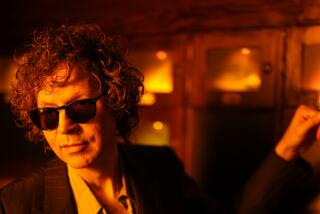They Helped Write the Book on Guitar in the Post-Bop Era
List the names of Joe Pass, George Benson, Al Di Meola and Pat Metheny and you’ve got a pretty good representation of the jazz guitar styles of the post-bebop era. Pass’ playing, of course, has deep roots in acoustically oriented straight-ahead jazz; Benson added blues and soul; Di Meola opened windows to fusion and world music; and Metheny has roved freely through all of the above--and then some.
This month sees the release of recordings from all four:
*** Pat Metheny, “Pat Metheny Trio>Live,” (Warner Bros.). If the title sounds familiar, it’s because the two-CD set is a live follow-up to “Trio 99>00,” released earlier this year. The personnel--Larry Grenadier on bass and Bill Stewart on drums--are the same, but the program is considerably more far-reaching. John Coltrane’s “Giant Steps” is revisited, with results as impressive than those on the earlier date, and there is a variety of Metheny works from earlier albums. But there also are three originals--”Night Turns Into Day,” “Faith Healer” and “Counting Texas”--that had never been recorded.
Trios with guitar, bass and drums can be difficult for players and listeners, largely because the guitar--unlike the piano--has relatively limited capacity to solo and accompany at the same time. And there are times when a two-CD stretch of material, even from someone with Metheny’s creativity, becomes a bit wearying. But his use of various instruments, including guitar synths, tends to quickly reinvigorate the proceedings, as does his extraordinary technique and capacity to move across stylistic boundaries.
*** Joe Pass, “Resonance,” (Pablo/Fantasy). In Pablo’s seemingly bottomless trove of Pass material, this CD is the second (the first was “Live at Donte’s”) chronicling a 1974 Pass trio appearance at the much-missed North Hollywood jazz club. And Pass--who was doing a great deal of solo performing at the time--was in fine form. He whips with characteristic ease through a program embracing standards (hard-romping versions of “It Could Happen to You” and “The Lamp Is Low,” and tender renderings of “Too Late Now,” “Come Rain or Come Shine” and “Misty”), as well as a floating bossa nova take on “Corcovado” and a boppish look at Charlie Parker’s “Yardbird Suite.” Impressive in every setting, Pass, who died in 1994, is especially touching in a solo interpretation of “How Deep Is the Ocean?” that reveals his capacity to use the amazing fluidity of his playing to keep the song front and center.
*** Al Di Meola, “Anthology” (Columbia Legacy). Another two-CD set, this collection covers Di Meola’s years as a Columbia solo artist, from 1975 (the year after he became part of Return to Forever) to 1982. Listen to his playing in the earlier tracks, and it’s easy to understand why he so quickly became the darling of young guitarists. Even more than John McLaughlin, who sometimes explored similar territory, Di Meola did not hesitate to completely blur the boundaries between rock and jazz, and had the technical skills to use elements from both to create an effective musical hybrid. In many of the tracks, he forecast the nouveau flamenco music that would arrive in the ‘80s and ‘90s. Other pieces set a pattern for many of the electronic-sounding New Age works that followed. There are groove-heavy fusion pieces; odd, contemporary classical-like outings; and, too briefly, a few examples of the stunning acoustic playing that became an important staple of Di Meola’s work in more recent performances.
*** George Benson, “Breezin’ Through Three Decades” (Warner Archives/Rhino). Rhino has done an impressive job of providing an overview of Benson’s career. Reaching back to his early work with Brother Jack McDuff on Prestige, including selections from his tenure on Columbia and CTI, this two-CD boxed set adds three tracks from his breakout Warner Bros. album “Breezin’,” as well as more recent hits such as “Give Me the Night” and “Turn Your Love Around,” and winds up with a pair of numbers from his current label, GRP/Verve.
The early efforts demonstrate his remarkable ease with both blues and jazz and, curiously, somewhat less-than-promising vocal skills in a 1966 version of “A Foggy Day.” But the quality of his playing on “Ready and Able” and “What’s New” makes it clear why so many jazz purists rue the fact that he has become such a crossover vocal star. Still, there’s no denying the sheer entertaining qualities of hits such as “This Masquerade” and “Nature Boy.” To Benson’s credit, his musicality is always present. And it’s good to know that if anyone’s going to be successful with smooth jazz, it’s someone who has the inherent ability to do quality work regardless of genre.
More to Read
Sign up for our Book Club newsletter
Get the latest news, events and more from the Los Angeles Times Book Club, and help us get L.A. reading and talking.
You may occasionally receive promotional content from the Los Angeles Times.






